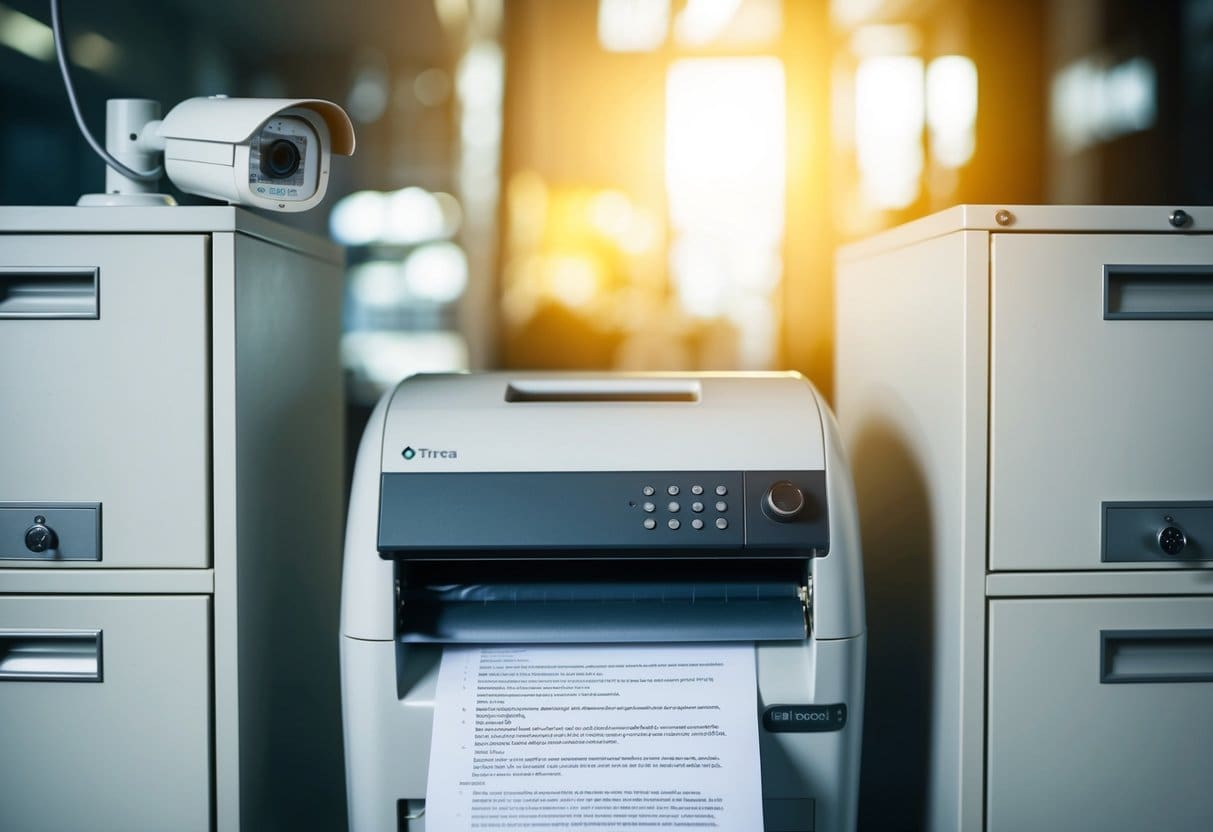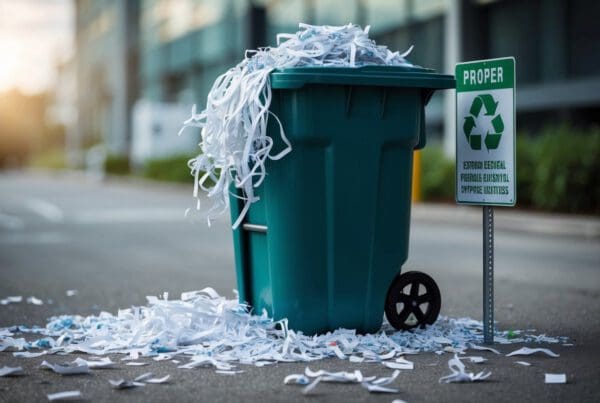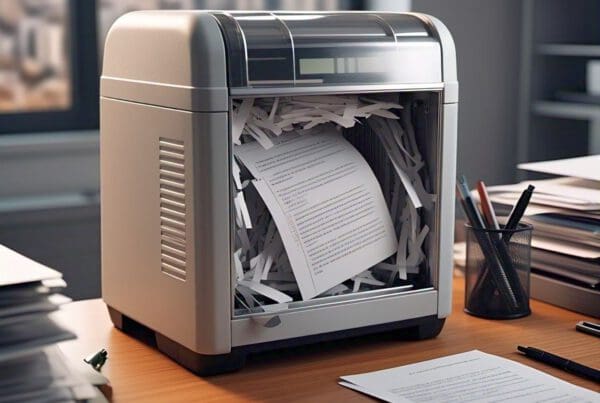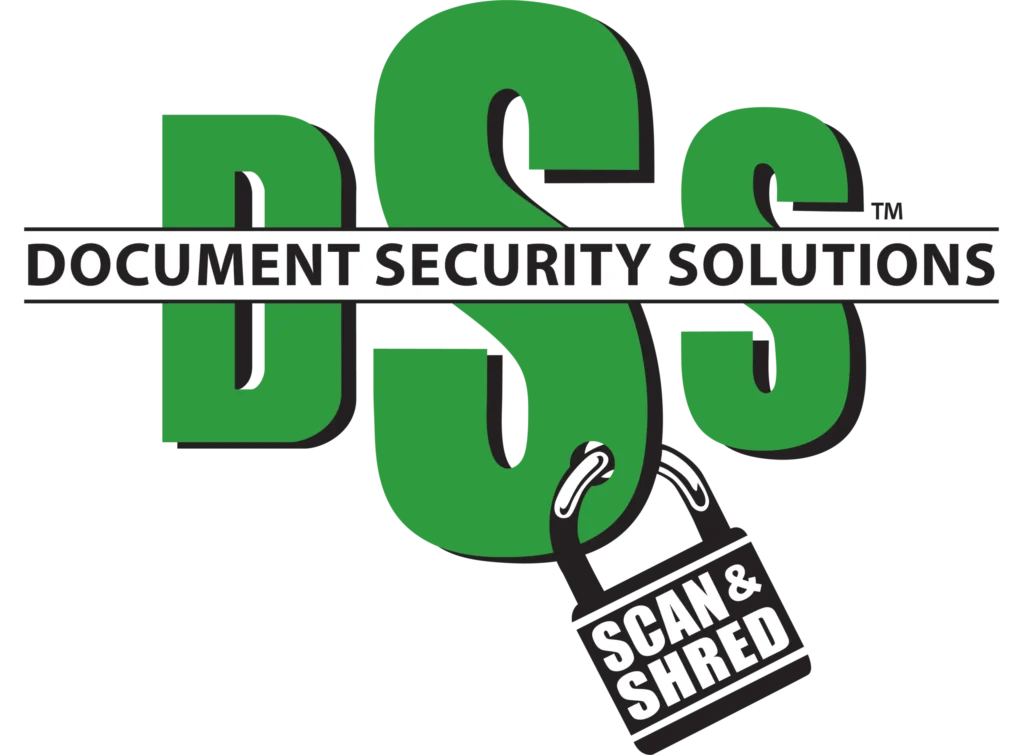Understanding Document Destruction

When we think about keeping our information safe, secure document destruction is crucial. It’s not just about shredding paper but also safely disposing of electronic media. We explore why secure destruction is important, different services available, shredding methods, and how we ensure a safe process from start to finish.
Importance of Secure Document Destruction
Secure document destruction helps protect sensitive information from identity theft and fraud. By properly destroying documents, we can prevent unauthorized access to personal and business data.
There are laws and regulations requiring businesses to destroy private information responsibly. Ensuring compliance with these rules avoids fines and protects reputations. We rely on secure processes to maintain trust and avoid data breaches.
Types of Document Destruction Services
Several document destruction services are available to meet different needs. Routine services help businesses manage paperwork regularly, while one-time shredding services handle occasional large purges. Bulk shredding is great for big piles of documents.
Some businesses need specialized destruction, such as media destruction services. We also have options like mobile shredding, where a truck comes to us, or off-site shredding, where documents get destroyed elsewhere.
Methods of Media and Document Shredding
Methods of shredding vary. Cross-cut shredding chops paper into tiny pieces, making reassembly impossible. Strip-cut shredding cuts paper into long strips but is less secure. For high-security needs, micro-cut shredding shreds paper into confetti-like bits.
Electronic media like hard drives require different methods. These may involve degaussing, crushing, or shredding. Choosing the right method depends on the sensitivity of the data.
Understanding the Chain of Custody in Document Destruction
The chain of custody ensures our documents are secure throughout the destruction process. It tracks who handles the documents from start to finish, guaranteeing their security. We receive certificates of destruction to confirm the effective completion of the process.
A clear chain of custody helps us maintain transparency and accountability. This way, we can trust that our sensitive information won’t fall into the wrong hands.
Legal and Compliance Considerations
Document destruction isn’t just a best practice; it’s a legal necessity. We must ensure compliance with numerous laws and regulations to protect ourselves from identity theft, legal penalties, and data breaches. Key laws like HIPAA, GLBA, and FACTA have specific rules about how to destroy confidential information.
The Role of Legal Requirements in Document Destruction
Legal requirements play a crucial role in determining how we manage document destruction. These rules are put in place to protect privacy and prevent information leaks. Failure to meet these requirements can lead to significant legal penalties and damage to our organization’s reputation.
Creating a robust document destruction policy ensures compliance. It defines the types of documents to destroy, how often destruction occurs, and the methods used. Regular audits can help us maintain compliance and avoid potential issues.
Understanding HIPAA, GLBA, and FACTA
Three major laws govern our document destruction practices: HIPAA, the Gramm-Leach-Bliley Act (GLBA), and FACTA. HIPAA focuses on protecting medical records and healthcare information. It requires us to properly destroy these records to maintain patient confidentiality.
GLBA covers financial institutions, mandating the protection of consumers’ personal financial information. The act requires safeguards for storing and disposing of such data. FACTA, on the other hand, emphasizes protection from identity theft by ensuring accurate information disposal. Each of these laws imposes strict rules we must follow to ensure compliance.
Achieving Compliance with Data Protection Regulations
Compliance with data protection regulations involves following steps to safeguard confidential information. This includes maintaining a chain of custody to track documents slated for destruction. By documenting this process, we can demonstrate our commitment to legal compliance and data security.
NAID AAA Certification is recognized as a standard for secure data destruction. It ensures that our processes meet industry standards and legal requirements. Regular employee training about these regulations also helps reinforce our compliance efforts.
Certificates of Destruction and Legal Proof
A Certificate of Destruction serves as legal proof that document destruction has occurred. This document indicates that we have adhered to all necessary legal requirements, reducing liability risks. It includes details such as the date of destruction, method used, and description of the destroyed materials.
Maintaining these certificates is vital in the event of an audit or legal dispute. They demonstrate our diligence in handling and destroying confidential information according to the set regulations. This ensures that our document destruction practices meet the highest standards of legal compliance.
The Benefits of Ensuring Confidentiality
Ensuring confidentiality brings peace of mind by protecting sensitive information and preventing data breaches. By maintaining secure document destruction, we safeguard personal data and comply with privacy regulations such as HIPAA.
Protecting Against Identity Theft and Data Breaches
Identity theft is a growing threat in our digital age. When confidential information is leaked, it can be easily exploited by criminals. By securely disposing of documents and ensuring they are not accessible to unauthorized individuals, we greatly reduce the risk of identity theft.
Data breaches not only damage reputations but also result in financial losses. Companies must implement strong confidentiality measures to protect their data. This is crucial for maintaining customer trust and avoiding legal issues. Secure document destruction plays a key role in preventing sensitive information from falling into the wrong hands.
Assuring Information Protection and Data Privacy
Information protection involves keeping our data safe from unauthorized access. Data privacy means respecting individuals’ rights to keep their information private. With strict confidentiality practices, we can protect both.
Our responsibility is to handle sensitive data with care. This includes financial records, personal data, and proprietary business information. The right measures ensure that this information remains private. Secure disposal of our documents reduces the risk of accidental leaks and unauthorized access.
Confidential Handling of Sensitive and Medical Records
Medical records contain highly sensitive information. Confidentiality assurance lets us comply with laws like HIPAA, which protects patient data. This ensures patients feel safe and their information is protected.
Proper handling includes secure storage and responsible destruction of outdated documents. This minimizes the risk of exposure. By focusing on confidentiality, we maintain trust with our patients and clients. Ensuring their data is safe is a vital part of our service.
Services and Features for Secure Shredding
Secure shredding services provide a safe way to destroy confidential documents. We explore key aspects such as mobile and on-site shredding, AAA certification, and convenient scheduling options.
Mobile and On-Site Shredding Convenience
In today’s fast-paced world, convenience in document destruction is essential. Mobile shredding services bring secure shredding right to our doorstep. These services ensure that documents never leave our sight before being destroyed.
We value the flexibility that on-site shredding offers. Businesses can opt for scheduled visits to manage regular document destruction or choose a one-time purge for large volumes. Secure mobile shredding helps maintain efficiency while prioritizing confidentiality.
Understanding AAA Certification and Standards
AAA certification is a gold standard in secure document shredding. This certification ensures that services follow strict procedures to protect our sensitive information. It guarantees that every step, from collection to disposal, is handled securely.
Being knowledgeable about these standards helps us choose trustworthy partners. AAA-certified services provide reassurance that our documents are handled with the utmost care. The certification covers secure paper shredding, transportation, and disposal processes.
Scheduling and Logistics of Secure Shredding Services
Systematic shredding requires practical scheduling and logistics. We can arrange for regular pickups or schedule shredding based on our unique needs. Pickup schedules are designed for flexibility, adapting to our timetable without disrupting business operations.
Secure shredding services often offer customized solutions with secure containers for collecting documents between shredding sessions. These services help us meet regulatory and environmental responsibilities by ensuring all materials are properly recycled after destruction. This approach supports our goals for sustainability and security.
Eco-Friendly Practices and Business Impact
Secure document destruction offers many benefits. By incorporating recycling efforts and optimizing office space use, we enhance both our environmental responsibility and productivity.
Recycling and Secure Disposal
When we shred documents securely, recycling becomes easier. Shredded paper can be collected and sent to recycling centers, where it is used to make new paper products. This diminishes the need for raw materials, conserving resources. Secure document destruction also ensures that any sensitive information doesn’t end up in the wrong hands, maintaining our commitment to privacy.
Taking responsibility for our environmental impact shows clients we care about both the planet and their security. We make sure our processes align with green practices by choosing shredding services that prioritize recycling. This commitment to sustainability not only protects data but also enhances our brand image.
Efficiency in Office Space Utilization and Productivity
With secure disposal and document destruction, we free up valuable office space. Storage areas previously filled with old files can now be repurposed. More space allows us to create efficient work environments, boosting productivity.
Fewer files mean less clutter, and a cleaner workspace fosters better focus. We also gain more room for necessary equipment or areas like break rooms, which contribute to a positive workplace atmosphere. Maximizing office space while ensuring data security supports both our business goals and environmental commitments.





